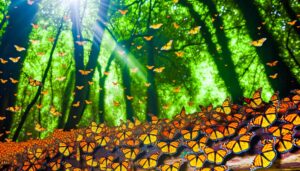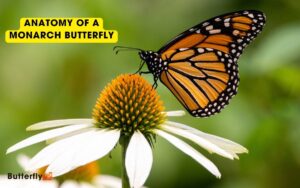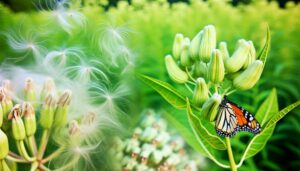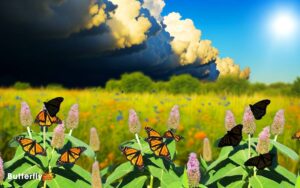What Stages Are in the Monarch Butterfly Life Cycle Video?
The monarch butterfly's life cycle begins when a female deposits a single egg on a milkweed leaf, which hatches into a caterpillar that undergoes five growth stages marked by molting. Feeding exclusively on milkweed, the caterpillar accumulates toxins for defense.
After its final molt, the larva forms a chrysalis, within which it undergoes metamorphosis, breaking down and reorganizing tissues. This culminates in the emergence of an adult butterfly with hardened wings, ready to set out on extensive migrations.
To understand more about this intricate lifecycle, consider exploring additional detailed resources on the subject.
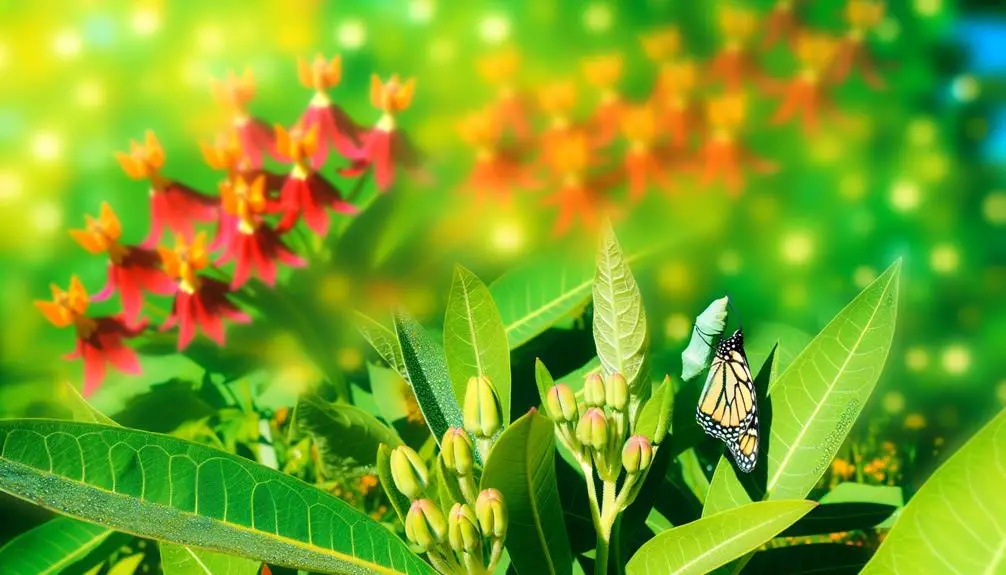
Key Takeaways
- Monarch butterflies undergo four stages: egg, larva (caterpillar), pupa (chrysalis), and adult.
- Female butterflies lay eggs on milkweed leaves, which hatch into caterpillars.
- Caterpillars feed on milkweed, grow through five molting stages, and form a chrysalis.
- The chrysalis protects the transforming butterfly, which emerges as an adult after 10-14 days.
Egg Stage
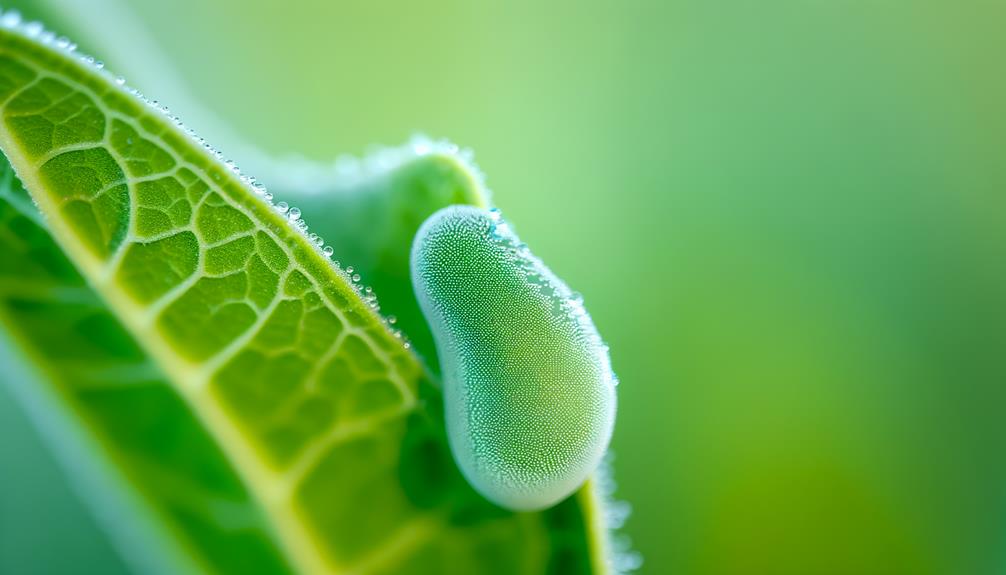
The egg stage of the monarch butterfly (Danaus plexippus) begins when a female deposits a single egg on the underside of a milkweed leaf, utilizing her specialized ovipositor. This strategic placement guarantees the egg's access to fundamental nutrients upon hatching.
Each egg, approximately 1.2 millimeters in diameter, is conical and ribbed, providing structural integrity. The egg's chorion, or outer shell, protects the developing embryo from environmental factors.
During the three to five days of embryogenesis, internal processes convert yolk nutrients into crucial tissues. The precise timing of hatching is influenced by temperature and humidity.
This stage is critical for the species' propagation, guaranteeing the next generation initiates its life cycle in an ideal environment tailored to its unique needs.
Larva Stage
The larva stage of the Monarch butterfly, commonly referred to as the caterpillar stage, is marked by significant growth and development through a series of molting phases known as instars.
During this period, the caterpillar mainly feeds on milkweed leaves, which provide essential nutrients and toxic compounds that deter predators.
Behavioral patterns observed include extensive feeding intervals and limited movement, primarily aimed at maximizing nutrient intake and ensuring successful progression to the pupal stage.
Caterpillar Growth Stages
Monarch caterpillars undergo five distinct growth stages, known as instars, each marked by a molt where the larva sheds its exoskeleton to accommodate its increasing size. These developmental phases are critical as they enable the caterpillar to grow rapidly, preparing it for the pupal stage.
During each instar, the caterpillar exhibits notable changes in size, coloration, and behavior, reflecting its physiological adaptations.
Key highlights of the instar stages include:
- First Instar: Newly hatched caterpillars are tiny, about 2-6 mm long, and feed primarily on milkweed leaves.
- Third Instar: By this stage, the caterpillar has grown considerably, reaching around 10-14 mm, and develops more pronounced banding patterns.
- Fifth Instar: The final and largest stage, with the caterpillar reaching up to 45 mm, preparing for pupation.
Diet and Behavior
Throughout the larval stage, monarch caterpillars exhibit highly specialized feeding behaviors, relying exclusively on milkweed plants to obtain essential nutrients for growth and development.
Milkweed serves not only as their primary food source but also as a defensive mechanism; the plant's toxic compounds, called cardenolides, are ingested by the caterpillars and retained in their bodies, making them unpalatable to predators.
This mono-diet is critical for their survival, as the toxins deter potential threats.
Larvae voraciously consume milkweed leaves, often stripping plants bare, to accumulate the necessary resources for subsequent metamorphosis.
Their feeding activity is characterized by continuous ingestion and rapid growth, facilitated by frequent molting, which allows them to increase in size exponentially while maintaining their physiological adaptability.
Molting Process
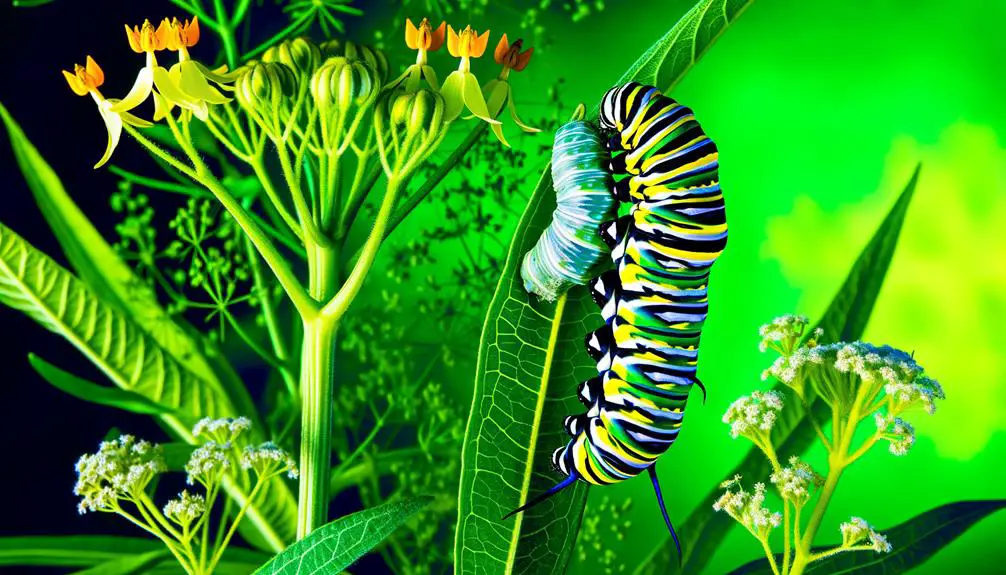
During the molting process, the monarch caterpillar sheds its exoskeleton multiple times to accommodate its rapid growth and development. This phenomenon, known scientifically as ecdysis, occurs five times throughout the larval stage. Each molt is critical for the caterpillar's survival and eventual transformation into a butterfly.
The molting process involves the following stages:
- Apolysis: The old cuticle separates from the underlying epidermis, initiating the molting cycle.
- Ecdysis: The caterpillar contracts its body to rupture the old exoskeleton, which is then shed.
- Post-ecdysis: The new, soft exoskeleton expands and hardens, providing renewed protection and flexibility.
Understanding these stages elucidates the complex biological processes that underpin the monarch's metamorphosis, offering insights into their remarkable adaptability and resilience.
Pupa Stage
Following the final molt, the monarch caterpillar enters the pupa stage, wherein it forms a chrysalis, a protective casing that facilitates its transformation into an adult butterfly.
During this critical phase, the caterpillar undergoes histolysis, a process where its larval tissues are enzymatically broken down.
Concurrently, histogenesis occurs, where the undifferentiated cells, known as imaginal discs, develop into various adult structures such as wings, legs, and antennae.
The chrysalis provides a secure environment for these complex biochemical processes, ensuring that the developing butterfly is shielded from external threats.
This stage is characterized by rapid cellular reorganization and differentiation, which is pivotal for the metamorphosis that enables the monarch to achieve its ultimate form, ready for flight and migration.
Chrysalis Formation

During chrysalis formation, the monarch caterpillar undergoes a critical phase where it molts and sheds its final layer of skin, revealing the chrysalis beneath.
This newly formed chrysalis initially appears soft and pale but undergoes significant color changes as it hardens into a protective shell.
These transformations are essential for safeguarding the developing butterfly from environmental threats and predators.
Molting and Shedding Skin
As the larva reaches its final instar, it initiates the molting process, shedding its exoskeleton to form the protective chrysalis necessary for metamorphosis. This critical phase of the monarch butterfly's life cycle involves a series of intricate steps:
- Hormonal Triggers: Ecdysone, a molting hormone, surges, signaling the larva to begin shedding its old cuticle.
- Cuticle Separation: The larva secretes enzymes that dissolve the connections between the old cuticle and the underlying epidermis, facilitating detachment.
- Chrysalis Formation: Once the exoskeleton is shed, the larva forms the chrysalis, a hardened outer shell that will safeguard the metamorphosis process.
This transformation is pivotal, ensuring the larva's progression into an adult butterfly.
Chrysalis Color Changes
The chrysalis of the monarch butterfly undergoes a series of distinct color changes, shifting from a vibrant green to a translucent hue as the metamorphosis progresses.
Initially, the green coloration serves as camouflage, blending with foliage to protect against predators. This stage lasts about 10-14 days, during which internal transformation occurs.
As the butterfly develops, the green chrysalis gradually becomes translucent, revealing the intricate patterns of the emerging butterfly's wings. This transparency indicates that the metamorphosis is nearing completion.
The color shift not only marks the developmental stages but also signals imminent emergence.
These changes are vital indicators for biologists and enthusiasts, reflecting critical physiological processes essential to the monarch's successful evolution from caterpillar to butterfly.
Hardened Protective Shell
Once the caterpillar has prepared for its metamorphosis, it forms a hardened protective shell known as the chrysalis, which provides a secure environment for its transformation into a butterfly.
The chrysalis undergoes several critical stages:
- Formation: The caterpillar secretes a silk pad and attaches itself to a surface using its cremaster, a specialized structure. It then molts its skin to reveal the chrysalis.
- Hardening: Initially soft, the chrysalis hardens to form a robust outer layer, shielding the vulnerable pupa from environmental threats.
- Transformation: Inside, the caterpillar's tissues are enzymatically broken down and restructured into the adult butterfly's anatomy.
This transformation is a marvel of biological engineering, exemplifying nature's intricate processes that guarantee the monarch's continuity and freedom.
Metamorphosis
During metamorphosis, the monarch butterfly undergoes a transformative series of stages, meticulously evolving from a larva to a fully developed adult. This process, known as holometabolism, involves a complete reorganization of its internal and external structures. Initially, the caterpillar forms a chrysalis, within which it liquefies its tissues, using cellular material to construct new body parts. This stage is critical for the development of wings, antennae, and other adult features.
| Stage | Description |
|---|---|
| Larva | Feeds and grows, preparing for transformation. |
| Chrysalis | Encloses the larva, where internal reorganization occurs. |
| Emergence | The adult butterfly breaks free, ready to continue its lifecycle. |
Metamorphosis exemplifies nature's intricate design, driven by genetic and hormonal cues.
Adult Butterfly
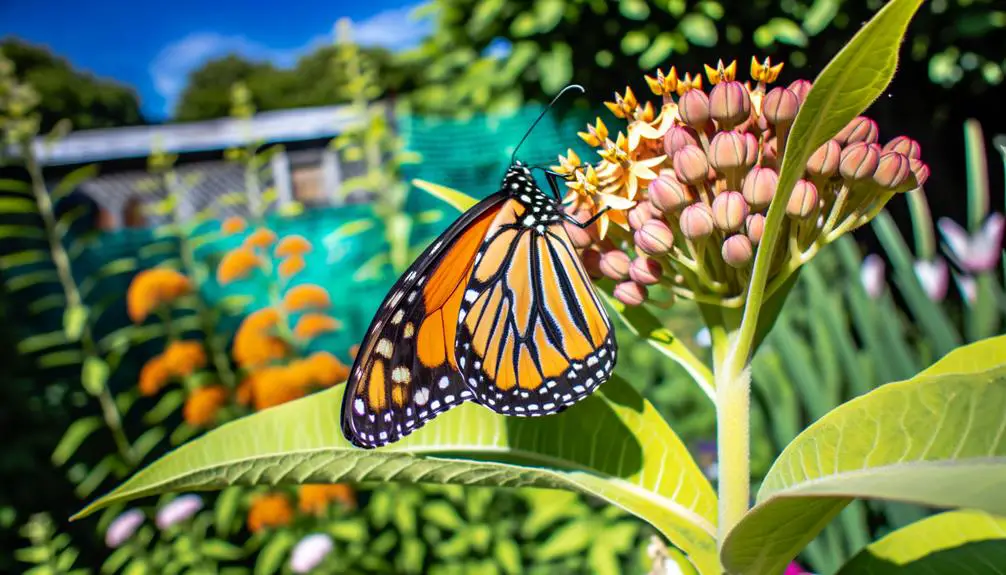
How does the monarch butterfly, now fully emerged as an adult, navigate its complex environment and begin its essential role in pollination and reproduction? Upon emerging, the adult monarch's wings must dry and harden before it can take flight. Its sensory organs, particularly the antennae and compound eyes, are finely tuned to detect floral resources and potential mates. As a pollinator, the monarch transfers pollen between flowers, aiding in plant reproduction.
Key aspects of the adult monarch's life include:
- Feeding: Monarchs utilize a proboscis to extract nectar from a variety of flowers.
- Reproduction: Males and females engage in intricate courtship behaviors, culminating in mating.
- Survival: Adults face multiple threats, including predation and environmental challenges, requiring keen survival strategies.
Migration Journey
Beginning their extraordinary migration journey, monarch butterflies travel thousands of miles from North America to central Mexico, guided by an innate biological compass and environmental cues.
This awe-inspiring phenomenon involves multiple generations, as no single butterfly completes the entire round trip.
Utilizing a combination of the sun's position, geomagnetic fields, and possibly polarized light patterns, monarchs navigate vast distances with remarkable accuracy.
During their southward trek, they face numerous challenges, including habitat fragmentation and climate variability.
The journey requires strategic energy conservation, with butterflies relying on fat reserves accumulated during their larval stage.
This migration not only exemplifies biological marvel but also underscores the intricate interplay between organism and environment, showcasing nature's capacity for resilience and adaptation.
Conservation Efforts
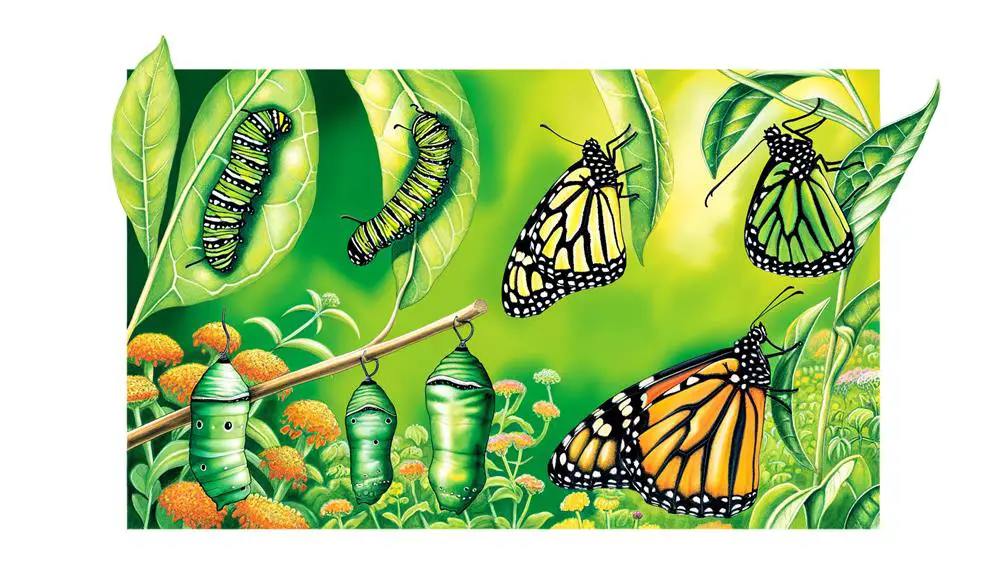
Recognizing the critical need to protect monarch butterflies, conservation efforts focus on habitat restoration, mitigating climate change impacts, and promoting sustainable agricultural practices. These efforts are crucial to guarantee the survival of this iconic species, which faces significant threats from habitat loss and environmental changes.
Key strategies include:
- Habitat Restoration: Planting milkweed and nectar plants to provide essential resources for monarchs during breeding and migration.
- Climate Change Mitigation: Implementing policies to reduce greenhouse gas emissions, thereby minimizing the adverse effects of global warming on butterfly habitats.
- Sustainable Agriculture: Encouraging farming practices that reduce pesticide use and maintain biodiversity, fostering a healthier ecosystem for monarchs and other pollinators.
These measures are fundamental for maintaining monarch populations and their migratory patterns.
Conclusion
The monarch butterfly life cycle video meticulously captures each developmental stage, from egg to adult, underscoring the intricate processes of molting, chrysalis formation, and metamorphosis.
A notable statistic reveals that less than 10% of monarch eggs survive to adulthood, highlighting the species' vulnerability.
This statistic emphasizes the importance of conservation efforts aimed at preserving critical habitats and mitigating threats.
Understanding these stages is essential for implementing effective conservation strategies to guarantee the monarch butterfly's continued existence.

